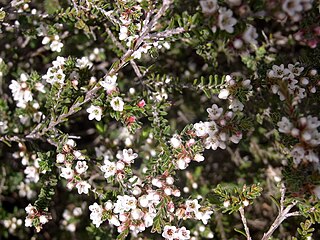
Micromyrtus blakelyi is a species of flowering plant in the family Myrtaceae and is endemic to a small area near Sydney Australia. It is a low, cushion-like shrub with overlapping, keeled, linear leaves and small pink flowers arranged singly in upper leaf axils.
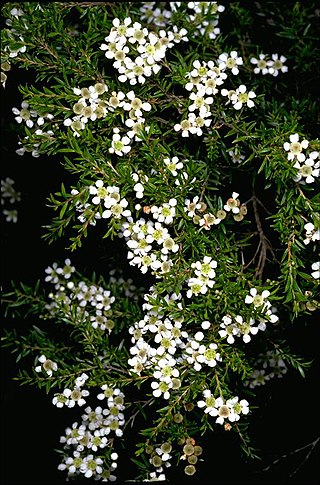
Sannantha similis is a species in the myrtle family, Myrtaceae and is endemic to eastern Australia. It is a shrub with narrowly lance-shaped leaves, and groups of three white flowers arranged in leaf axils.
Micromyrtus barbata is a species of flowering plant in the family Myrtaceae and is endemic to inland areas of Western Australia. It is a shrub with small, overlapping, narrowly egg-shaped leaves and small white flowers arranged singly in upper leaf axils.
Homoranthus tricolor, is a flowering plant in the family Myrtaceae and is endemic to a small area in south-east Queensland. It is an upright shrub with linear to lance-shaped leaves and green, red and black flowers arranged singly or in pairs in upper leaf axils.
Leptospermum pallidum is a species of spreading shrub that is endemic to Queensland. It has thin, firm, rough bark, narrow lance-shaped leaves, white flowers arranged in groups of two or three on side shoots and fruit that remains on the plant until it dies.

Philotheca queenslandica is a species of flowering plant in the family Rutaceae and is endemic to south-eastern Queensland. It is a wiry shrub with elliptic to egg-shaped leaves with the narrower end toward the base and densely crowded near the ends of the glandular-warty branchlets, and cream-coloured flowers tinged with pink and arranged singly in leaf axils.
Triplarina bancroftii is a species of flowering plant in the myrtle family, Myrtaceae and is endemic to a restricted area of Queensland. It is a shrub with egg-shaped or elliptic leaves, flowers with five sepals and five relatively small white petals and sixteen to eighteen stamens.
Triplarina calophylla is a species of flowering plant in the myrtle family, Myrtaceae and is endemic to a restricted area of north Queensland. It is a shrub with egg-shaped leaves with the narrower end towards the base, flowers with five sepals, five white petals and fourteen or fifteen stamens.
Triplarina nitchaga is a species of flowering plant in the myrtle family, Myrtaceae and is endemic to a restricted area of north Queensland. It is a shrub with lance-shaped leaves with the narrower end towards the base, flowers with five sepals, five white petals and seventeen or eighteen stamens.

Triplarina volcanica is a species of flowering plant in the myrtle family, Myrtaceae and is endemic to Queensland, where it is only found in three mountainous areas. It is a shrub with elliptical to egg-shaped leaves with the narrower end towards the base and flowers with five sepals, five white petals and fourteen to sixteen stamens.

Thryptomene parviflora is a species of flowering plant in the family Myrtaceae and is endemic to Queensland. It is a slender, erect shrub with decussate, linear to egg-shaped leaves with the narrower end towards the base, and flowers with five petals and five stamens arranged singly in leaf axils.
Thryptomene remota is a species of flowering plant in the family Myrtaceae and is endemic to the northern part of the Northern Territory. It is an erect shrub with linear to lance-shaped leaves with the narrower end towards the base, and white or cream-coloured flowers with ten stamens.
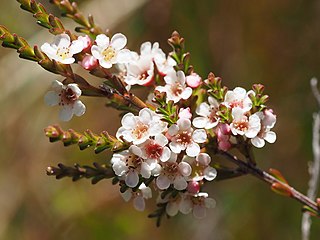
Baeckea omissa is a species of flowering plant in the family Myrtaceae and is endemic to eastern Australia. It is a shrub with egg-shaped to lance-shaped leaves with the narrower end towards the base and white flowers mostly with ten to fifteen stamens.

Leucopogon cuspidatus is a species of flowering plant in the family Ericaceae and is endemic to the central Queensland coast. It is a shrub with densely hairy young branchlets, egg-shaped to lance-shaped leaves with the narrower end towards the base, and white, bell-shaped flowers that are bearded inside.
Cryptandra ciliata is a species of flowering plant in the family Rhamnaceae and is endemic to south-eastern Queensland. It is a shrub with clustered linear leaves and densely-hairy, white, tube-shaped flowers.
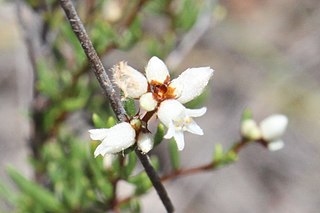
Cryptandra debilis is a species of flowering plant in the family Rhamnaceae and is endemic to north Queensland. It is a small shrub with clustered, linear leaves and densely-hairy, white, tube-shaped flowers.
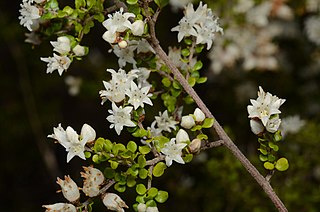
Cryptandra orbicularis is a species of flowering plant in the family Rhamnaceae and is endemic to south-eastern Queensland. It is a shrub with more or less round or kidney-shaped leaves and white to creamy-white, tube-shaped flowers.
Sannantha angusta is a species of flowering plant in the family Myrtaceae, and is endemic to eastern Australia. It has scaly to fibrous bark, narrowly lance-shaped to linear leaves and white flowers, and usually grows in forest on rocky hillsides. It was previously known as Babingtonia angusta, and has been cultivated as Baeckea sp. 'Clarence River'.
Micromyrtus albicans is a species of flowering plant in the myrtle family, Myrtaceae and is endemic to a small area of south-eastern Queensland. It is a slender shrub with overlapping, egg-shaped leaves and small white flowers.
Micromyrtus capricornia is a species of flowering plant in the myrtle family, Myrtaceae and is endemic to a small area of central eastern Queensland. It is a shrub with slightly drooping branchlets, overlapping, narrowly egg-shaped leaves and small white flowers.








